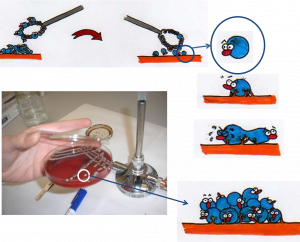3. Isolation and Count technique
Overview
When handling contaminated samples or mixed cultures in which there are different microorganisms, the first step involved in the study is the isolation, that is to say the separation of each of the possible microbes that make up the sample.
There are different methods that can be used for this separation; the majority of them are based on the immobilization of the microbial cells on the surface of the solid growth media. When a bacterial cell or yeast is put on a point of the culture medium, it will be immobilized on this point and it will reproduce on it by absorbing the nutrients of the culture media. The new cells produced will also be immobilized and after consecutive cells have grown they will form what is known as a “colony”, which is simply a lot of cells that are derived from one single parent cell, that is to say, a clone of the bacteria or the yeast that is put on the plate to grow. This colony can be seen with the naked eye and it has different characteristics according to the microorganism that it produces. This means that the different microbial populations, which exist in the inoculated sample, can be distinguished and separated by transferring one colony of each type onto a new sterile culture medium, to those cultures that are considered to be “pure” because they only have one type of microorganism. (The basis is valid taking into account only cultivable microorganisms).
Objectives
- Distinguish the pure culture and mixed culture concepts.
- Use isolation techniques to locate specific microorganisms in contaminated samples or with mixed biota.
- Use the most common streaking techniques and the streak plate method used to isolate cultivable microorganisms.
- Observe the influence that the temperature has on the development of the microorganisms.
Carrying out the practical
Isolation techniques. The microorganisms that exist in a mixed culture in ordinary broth, on a nutrient agar plate are isolated. Two nutrient agar plates are inoculated, one by means of the inoculation loop streaking technique and the other by means of the streak plate method and the quadrant streak plate technique.
These techniques are used to dilute the microbial load that is applied on the culture medium so that, in the last lines of the inoculation, there are only a few cells that are suitably separated from each other to grow separate colonies.
Isolation and count technique: the serial dilution A series of serial dilutions from a mixed culture is obtained. This technique is also used to isolate colonies and count the number of bacteria that exists in the culture.
Educational Innovation Activities Assistance- Vice Rector for Academic Affairs/ Enquiries and technical matters – Tel: 96 522 2059 –
